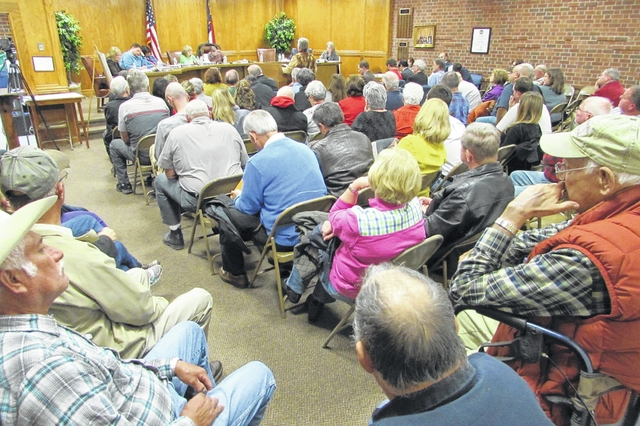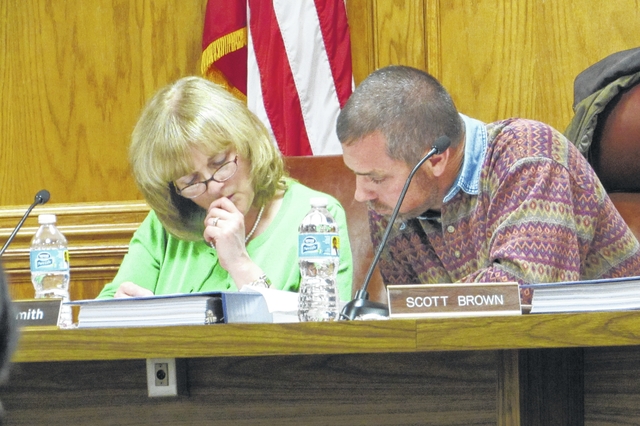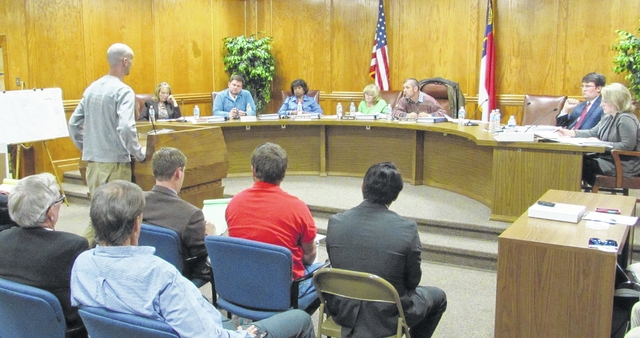Around 1:30 a.m. Wednesday, some audience members at the Sampson County Planning Board meeting started filing out of the City Hall Auditorium before the marathon session on a High House Road mining request was done.
For the opposition-heavy crowd, it seemed to be a foregone conclusion that a special use permit would be granted for the mining venture as the board was mulling buffer stipulations — minimum tree height along the property and stockpile height among them — on their way to unanimously approving the second of four standards that must be met.
Then it took a turn.
For a special use permit to be granted, the board had to find four things, including that the use: would not materially endanger the public health or safety; met all required conditions and specifications; would not substantially injure the value of adjoining or abutting property; and would be in harmony with the area and in general conformity with the Sampson County Land Use Plan.
The last two were sticking points for some board members, as more than a dozen people spoke adamantly in opposition, most at great length, each stating they believed the use was simply not in harmony with their residential agricultural community.
However, attorney Andrew Jackson, representing the applicant, Drafting and Design Services, Inc., told the board lay testimony was not admissible, citing N.C. General Statute that noted residents’ “belief” that a use would be harmful was considered opinion and did not carry the same weight as expert testimony.
But the parade of opposition — some seemed to border on filibustering as Tuesday crept well into Wednesday — stuck in a couple board members’ minds, and proved to be enough, with the last two conditions regarding effect on property values and harmony met with a split 3-2 vote in favor of mine approval. Chairman Scott Brown, Gary Mac Herring and Nancy Blackman supported the request, but Debra Bass and Sherri Smith dissented.
That was enough to deny the permit.
While it was a majority in approval of the mine, the board was missing members Ann Naylor and Gary Henry, who Brown said were not allowed to be present for Tuesday’s proceedings as they were not at last week’s session when the High House discussion began. A 3-2 approval presented a “simple majority” on the seven-person board, which requires four votes to pass a motion.
So the mining request died at 2 a.m., leaving Drafting and Design Services to appeal the ruling to Superior Court. That decision followed a nearly eight hour meeting. The board met for nearly seven hours on mining issues last week.
‘Pitchforks and fire’
Leading up to the decision, and after about six hours of residents in the community sharing their concerns about pollution, noise, traffic and blight on the “scenic” rural setting, Jackson maintained in his closing argument that law was “very clear.”
While he heard their concerns, his case was backed by expert witnesses offering “competent, material and substantial evidence” that revealed the mines would have no negative impact to the adjoining, abutting or nearby properties. There was no such testimony on the other side, he said.
“We’ve waited patiently and listened to everyone speak and they believe it is not in harmony,” Jackson stated. “We have heard lay opinion and speculation about dust. That is insufficient. They can’t just say ‘we don’t want it.’ There has to be facts.”
He pointed to active mines on Peavine Road and Murphy Road, which some did not know about. Others were aware, but said they were small and only semi-active, and not a fair comparison to the proposed High House venture’s roughly 300-acre tract, of which half was proposed to be developed.
“These are two mines that are in harmony,” said Jackson. “We have the pitchforks and fire out here and they’re saying we can’t use the land for that. Well, it’s already here. There is no reason to not grant this permit. We’ve heard everything from speculation to flat-out irrelevant information. This board must be consistent.”
The Big Easy mine on Fleet Naylor was approved last week, on the heels of the White Sands Mine in close proximity to that area in September. Discussion on the High House mine started last week and carried over to Tuesday. In all the board spent 10 hours in discussions about High House, opting to push talks about the proposed Five Bridge Road mine to Dec. 10 at 6:30 p.m. All land is owned by County Commissioner Clark Wooten.
Hardy Ballance, Billie Jo King, Brent Lewis and Carrie Cooper were just a handful of the more than a dozen people who spoke to the negative effects the mining operation would have in their neighborhood.
“Five generations of my family have been able to live on the farmland for 90 years in harmony with the community. We would like for our children and grandchildren to do the same thing,” said Ballance. “A mining operation will not be in harmony. This is not a service to benefit the county. This is for personal gain.”
Ballance, who noted a background in manufacturing, said such ventures only attempt to grow bigger to meet larger goals, which would boost those negative impacts even further.
“That will lead to more traffic and more dust,” he said. He suggested the board stick with the Big Easy mine and gauge the impacts before moving forward with permitting others.
“Let’s start off small,” he implored.
King said she felt the mine would have a “blighting and downgrading effect on our community.”
“I believe their projections on property values are incorrect,” she remarked, noting previous expert witnesses. “I know you do not want to hear our opinions but I do ask before dooming our community you do your own research. I am afraid our hometown, quaint community will turn into a mining community. When you drive down Five Bridge Road in 10 years, will you be proud of the decision that was made here tonight?”
Cooper brought the board back to the letter of the four conditions, notably the last one. To be achieved, the use had to be permitted and conform to the Land Use Plan, but also be in harmony with the area.
“Those are two distinct and specific elements,” Cooper attested. “You’ve been led to believe that mining is a special use and that is all that is required. This is an ‘and’ not an ‘or.’ We may not have any special degrees or be considered experts, but who is more knowledgeable than the people of this community on harmony? These are the people who will be the most affected.”
She made a plea to the board to deny the permit.
“These are people who lived on this land for generations and hope for the best for the future,” said Cooper, listing off her mother and aunt as just two of the elderly residents of the community who would be subjected to faster-declining health should a mining operation take hold. “They will have those hopes killed forever. There is no undoing this once this is done.”
“Look at the number of people opposed to this,” she implored the board. “These people all live in harmony with each other in the community, one they believe will be destroyed by this operation. I am asking you to use your reasoning and common sense. It’s been made crystal clear that this will disrupt the harmony of our community.”
Lewis said he was already feeling the ill effects of the mine’s presence, even though it was not even there yet. Trying to sell his house on Five Bridge Road, he had an agreed-upon price. However, after the sale was delayed around the same time the mine discussion began in the community earlier this year, Lewis noticed interest waned and offers ceased. He was forced to drop the asking price by $10,000 from the previously agreed-upon price, $15,000 from the original asking price.
There was a “drastic reduction” in people interested in even looking, he noted.
“There was no testimony (from the applicant) from people who actually tried to sell their house and were unable to,” Lewis explained. “I feel like my testimony addresses that.”
Similar to Ivanhoe
In previous testimony, Michael Blakley of Drafting and Design Services, Inc. asserted that the use would not substantially decrease the value of adjoining properties and was in harmony with the area. It was “wet dredging” operation, and would not bring dust with it. There were air quality and other mandates by which such operations are governed.
“Stockpiles are wet and a water truck will be used if they get dry,” said Blakley said. “Essentially, what we’re doing is building a pond and selling the materials we get out of it.”
On Tuesday, he expounded on that at the behest of Brown and other board members. He said it could be between two to three years before the operation gets past the “overburden” in the foundation and becomes a wet-dredging operation. Up to that point it will be similar to American Materials Co. in Ivanhoe, pictures of which were used by opposing residents to show how dusty the High House operation could be.
“For the first two years, it will be similar to Ivanhoe with trucks and excavators,” Blakley pointed out. “Then when we get to the desired materials, the wet dredging begins.”
During board discussions Tuesday, Brown asked whether the mining site could be moved further off the road to appease some concerns. Blakley said that was not feasible.
“If we could put it to the back of the property we would have,” he stated. “It is not economically feasible. That material is not there.”
Attorney Clifton Hester, representing those in opposition to the High House request, said in his closing arguments that, despite Jackson’s statements about the burden shifting to the opposition, he felt the burden still rested firmly on the applicant’s shoulders.
They had not proved anything, he said, using projections from other counties to predict the effect of mines in Sampson, where they had little if any data.
“(Blakley) said it would be like Ivanhoe for 2-3 years. Will planting trees prevent these homes from being in a dust storm? If they raised questions in your mind, it is your duty, not another entity’s, to decide what is healthy and safe for your citizens,” said Hester. “If the question is raised, the burden is on them, not the people. You are being sold something in this case. Is it in harmony? The public has spoken here tonight.”
After all arguments were made on both sides, the board mulled the decision for an hour, taking each condition one at a time.
“It is tough,” Brown said just before 1 a.m. as board members began discussions among themselves.
“I’ve lived around gravel pits my entire life,” said Blackman. “It’s tough to prove that it’s going to materially endanger public health. I don’t think it will.”
“I agree,” Herring added.
Talks on setbacks and buffers were agreed upon among the board, with the public hearing opened again to get assurances from Jackson and Blakley that stipulations were similarly agreeable, before talk of harmony and property values split the board, with Bass and Smith saying they believed there would be negative impacts.
“I’m not really sure it would be in harmony,” said Bass, who last week voted to approve the Big Easy mine. “Because that is an agricultural district, but this is something entirely different.”
Smith mentioned the active mines on Peavine and Murphy roads, the crux of the applicant’s argument Tuesday that showed harmony was already achieved with such operations locally.
“There are two gravel pits there,” said Smith, “but they look different to me.”



